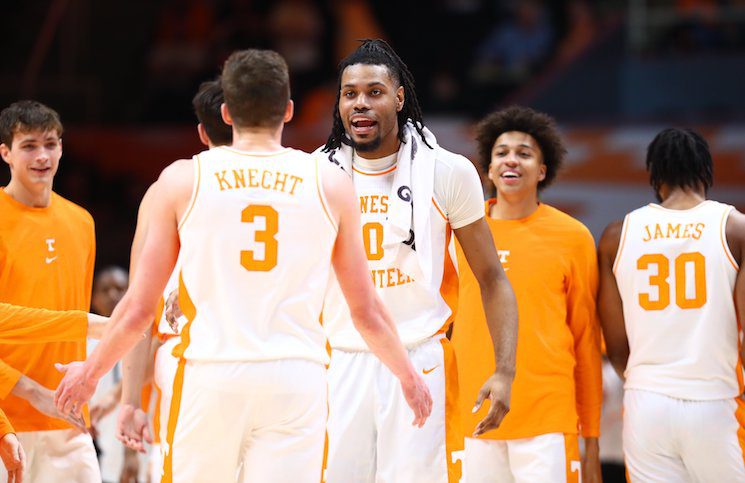
If you’ve felt like Tennessee’s men’s basketball team has been playing a different style of basketball this year, the numbers justify what you’ve seen.
The Vols are sitting pretty with a 14-4 overall mark and a 4-1 record in SEC play this season. Tennessee is a consensus top-10 team among all major rankings and analytical services, and they’re a top-5 team on many of those. And for once, it’s not just because they have a stifling defense.
Tennessee’s offense this season is performing at a level Vol fans haven’t seen since the Grant and Admiral days.
Currently, the Vols are averaging 79.7 points per game, which is the highest mark since the 2018-19 squad that averaged 82 points per game. It’s almost a whole nine points higher than what last season’s team averaged on the offensive end of the court (70.8 PPG). Tennessee’s offensive efficiency currently ranks 20th on KenPom, which is their highest ranking since the 2018-19 team finished 3rd in offensive efficiency, and it’s the second-best offensive efficiency ranking of the Rick Barnes era at Tennessee.
The Vols’ offensive tempo is at an all-time high under Rick Barnes as well. According to KenPom’s adjusted tempo metric, UT is averaging 69.9 possessions a game, which ranks 85th in the country. That’s Tennessee’s highest average possession amount under Barnes, and it currently marks Tennessee’s fastest tempo since the 2007-08 team averaged 70.7 possessions a game.
All of this offense hasn’t come at the expense of UT’s normally stout defense, though.
Tennessee’s defensive efficiency on KenPom is still among the best in the country, ranking second behind only Houston. The Vols’ increased tempo means they’re giving up more points per game than they have over the last five years, but they’re still only allowing 66.3 PPG and are holding teams to a paltry 37.8% shooting percentage.
In short, the Vols are elite on both ends of the court, which is the first time under Rick Barnes that Tennessee has been able to say that.
Right now, Tennessee is just one of seven teams to have both an offensive and defensive efficiency ranking inside the top 20 on KenPom. The other teams are Houston, North Carolina, BYU, Auburn, Arizona, and Purdue. Notably, the Vols have played two of those teams (UNC and Purdue) and have a match-up with Auburn on Feb. 28 still on the schedule.
Why is being in the top 20 of both metrics significant? Because the vast majority of teams that have made Final Four runs over the last decade have had both their offense and defense rank in the top 20 on KenPom.
I dug back over the last 10 NCAA Tournaments from last year to 2013 (the 2020 NCAA Tournament was canceled due to COVID) to see what KenPom had to say about those teams. As it stands right now, Tennessee’s analytical resume has them positioned favorably with what history says it takes to get to the Final Four — a place the Vols have never been.
More From RTI: Jordan Gainey Breaks Out Of Slump Against Alabama
Over the last 10 NCAA Tournaments, three-fourths of the teams that made it to the Final Four had an offensive efficiency ranked in the top 20 on KenPom. All but one national champion (2014 UConn) had an offensive efficiency ranked in the top 10. Almost two-thirds (62.5%) of the 40 Final Four teams over the last 10 tournaments had a defensive efficiency in the top 20. Only one national champion (2021 Baylor) had a defensive efficiency ranked outside the top 15.
All in all, 16 of the last 40 Final Four teams (40%) were ranked in the top 20 in both offensive and defensive efficiency on KenPom, and a handful of others had at least one of those metrics rank inside the top 25. The average offensive efficiency ranking of the last 40 Final Four teams is 16.9, and the average defensive efficiency ranking is 19.9.
There are, of course, some notable outliers. South Carolina in 2017 ranked 3rd in defensive efficiency but 91st on offense, and 2018 Loyola-Chicago ranked 63rd on offense and 17th on defense. Last year saw one of the most unlikely Final Fours ever, especially according to the metrics. Only UConn had offensive and defensive efficiencies ranked in the top 20, as San Diego State, Miami, and FAU all had at least one of those metrics well beyond the top 20.
It’s not necessary to have both an elite offense and defense to make it to the Final Four. But for a program that has never made it that far in the Big Dance, it’s better to be inside those historical parameters than outside.
The odds of the Vols finally making their first Final Four run in school history appear to be the best they’ve been in at least half a decade, if not longer. According to TeamRankings.com, the likelihood of Tennessee making the Final Four sit at 24.3%, which is the 4th-best percentage in the country. The Vols are in the conversation of being a possible one-seed in the NCAA Tournament and appear destined to at least be a two-seed as things sit right now. Since 2013, over half (55%) of all Final Four teams were one- or two-seeds.
If Tennessee keeps up their strong offensive performances to go along with their always-exceptional defense, they’ll have the statistical makeup of teams that have gone that far in the last 10 tournaments.
If you want to look at all the data I compiled of Final Four teams over the last decade, check it out below:
italics = national champion
2013
Louisville – 7th offense, 1st defense
Michigan – 1st offense, 37th defense
Syracuse – 26th offense, 6th defense
Wichita State – 35th offense, 20th defense
2014
UConn – 39th offense, 10th defense
Kentucky – 14th offense, 32nd defense
Florida – 19th offense, 3rd defense
Wisconsin – 4th offense, 35th defense
2015
Duke – 3rd offense, 11th defense
Kentucky – 6th offense, 1st defense
Wisconsin – 1st offense, 35th defense
Michigan State – 14th offense, 27th defense
2016
Villanova – 3rd offense, 5th defense
Oklahoma – 16th offense, 17th defense
North Carolina – 1st offense, 21st defense
Syracuse – 50th offense, 18th defense
2017
North Carolina – 9th offense, 11th defense
Gonzaga – 16th offense, 1st defense
Oregon – 17th offense, 17th defense
South Carolina – 91st offense, 3rd defense
2018
Villanova – 1st offense, 11th defense
Kansas – 3rd offense, 47th defense
Michigan – 35th offense, 3rd defense
Loyola-Chicago – 63rd offense, 17th defense
2019
Virginia – 2nd offense, 5th defense
Texas Tech – 25th offense, 1st defense
Auburn – 6th offense, 36th defense
Michigan State – 5th offense, 9 defense
2021
Baylor – 2nd offense, 22nd defense
Gonzaga – 1st offense, 11th defense
Houston – 7th offense, 9th defense
UCLA – 11th offense, 46th defense
2022
Kansas – 6th offense, 17th defense
North Carolina – 18th offense, 35th defense
Duke – 1st offense, 49th defense
Villanova – 9th offense, 23rd defense
2023
UConn – 3rd offense, 7th defense
FAU – 22nd offense, 34th defense
San Diego State – 75th offense, 4th defense
Miami – 6th offense – 99th defense



